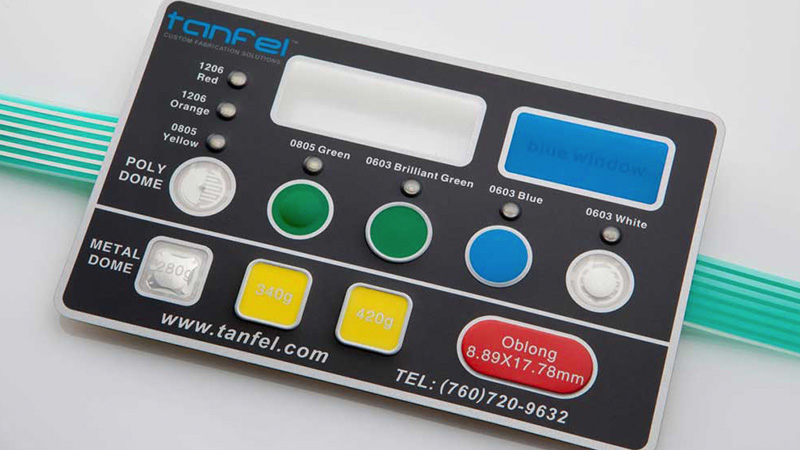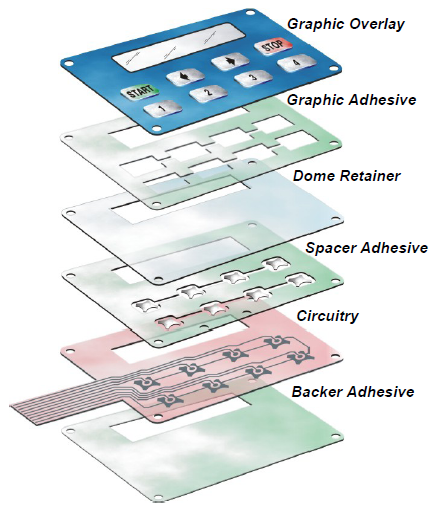How Membrane Switches Are Revolutionizing User Interface Design
How Membrane Switches Are Revolutionizing User Interface Design
Blog Article
Recognizing the Importance of Membrane Switches in User Interfaces
Membrane switches are integral parts in the design of effective interface, helping with not only performance however likewise improving aesthetic appeal and individual communication. Their unique functions, such as resistance to adjustable styles and environmental elements, make them suitable for a varied range of applications across numerous sectors. As we check out the future fads and numerous advantages connected with Membrane modern technology, it comes to be clear that these buttons are greater than just parts; they stand for a convergence of technology and usefulness. The ramifications of this innovation on user experience deserve analyzing further.
What Are Membrane Switches?

The spacer layer, which contains adhesive residential or commercial properties, permits the separation of the circuit layer from the overlay, ensuring that the button continues to be in a non-activated state up until pressed. When stress is used to the overlay, it compresses the spacer layer, bridging the void and finishing the circuit in the underlying layer. This layout not only reduces the physical room needed for standard mechanical switches yet likewise boosts the resilience of the tool, as Membrane switches are typically resistant to dirt, dampness, and other environmental variables.
Frequently found in applications ranging from customer electronics to clinical gadgets, Membrane switches are integral to modern-day technology, giving a user-friendly and effective interface that lines up with modern style needs.
Advantages of Membrane Buttons
While many button innovations exist, Membrane Switches deal distinctive advantages that make them especially preferable in various applications. Among the primary benefits of Membrane buttons is their compact style, which permits for space-saving implementations in tools where real estate is limited. Their slim account not just improves aesthetic allure but also promotes lightweight building.
One more substantial advantage is their resistance to ecological factors. Membrane buttons are generally secured versus wetness, dirt, and pollutants, making them perfect for usage in requiring atmospheres, such as clinical devices and commercial equipment. This toughness expands the life-span of the button, minimizing maintenance costs and boosting integrity.
Moreover, Membrane buttons can be customized to fulfill particular style requirements, incorporating unique graphics and colors that enhance user interaction. Their tactile responses choices can likewise be tailored to supply a rewarding user experience. Additionally, Membrane switches are cost-efficient, particularly in high-volume applications, as they can be produced effectively.
Applications in Numerous Industries

In the customer electronics industry, Membrane buttons prevail in tools such as microwaves, cleaning devices, and push-button controls. Their responsive responses and visual alternatives improve individual experience while offering a streamlined, contemporary look. Furthermore, automotive suppliers utilize Membrane switches in dashboard controls and infotainment systems, where space is restricted, and user involvement is important.
Furthermore, the industrial market leverages Membrane buttons in control panels for equipment and equipment, enabling for user-friendly operation in often extreme environments. Their resistance to chemicals and dampness guarantees long life and reliability in these applications. Overall, the adaptability of Membrane Switches contributes substantially to their widespread usage, making them essential in different technological domain names.
Design Considerations for Membrane Buttons

When designing Membrane switches, several vital factors to consider should be considered to make certain optimal capability and user experience. The option of products is critical; selecting resilient, premium substratums can boost the switch's longevity and resistance to environmental aspects such as wetness and temperature variations.
Second of all, the design of the visuals overlay should focus on clarity and simplicity of usage. Icons and text should be understandable, and the design ought to help with user-friendly communication (membrane switches). Furthermore, responsive responses is important; including a tactile dome or other devices can improve the user experience by providing physical verification of activation
One more crucial variable is the switch's electrical efficiency. Designers must guarantee that the conductive traces are effectively developed to decrease resistance and avoid signal interference. This entails evaluating the needed actuation pressure and guaranteeing compatibility with the electronic parts they will certainly user interface with.

Future Fads in Membrane Technology
As technology remains to development, Membrane switches are positioned to advance substantially, driven by advancements in products and manufacturing methods. One arising trend is the consolidation of advanced materials, such as versatile substratums and conductive inks, which boost sturdiness and reduce the total weight of Membrane buttons. These materials not only improve the tactile response but likewise allow for the style of buttons that can hold up against harsher environmental read more conditions.
Additionally, the integration of touch-sensitive technologies is changing traditional Membrane Switches right into even more interactive user interfaces. Capacitive touch sensors installed within Membrane switch panels can supply a more intuitive and receptive customer experience, lining up with the expanding need for smooth, contemporary styles in consumer electronic devices.
In addition, innovations in printing strategies, such as electronic and 3D printing, allow rapid prototyping and customization of Membrane switches. This versatility enables producers to respond extra promptly to market demands and consumer choices.
Finally, sustainability is becoming a significant emphasis, with producers exploring eco-friendly products and procedures. As these trends unravel, the future of Membrane modern technology guarantees enhanced capability, aesthetic allure, and ecological responsibility, strengthening their role in innovative user interfaces throughout different markets.
Conclusion
Finally, Membrane Switches represent an essential component check out this site in the layout of interface, incorporating functionality with visual versatility. Their advantages, including toughness and resistance to environmental variables, make them appropriate for varied applications across different sectors. Thoughtful layout considerations improve user interaction and experience. As improvements in modern technology proceed, the evolution of Membrane buttons read what he said is anticipated to additional fine-tune interface, driving innovation and enhancing usability in a significantly intricate technical landscape.
Membrane buttons are indispensable elements in the style of effective user interfaces, facilitating not only functionality yet also improving visual appeal and customer communication.Membrane Switches serve as a vital component in different customer interfaces, promoting a seamless interaction between customers and digital tools.While numerous button modern technologies exist, Membrane Switches offer distinctive advantages that make them specifically desirable in numerous applications.Additionally, Membrane switches can be tailored to satisfy details design needs, including special graphics and colors that enhance individual communication.In conclusion, Membrane Switches represent an important component in the layout of individual interfaces, combining capability with visual adaptability.
Report this page